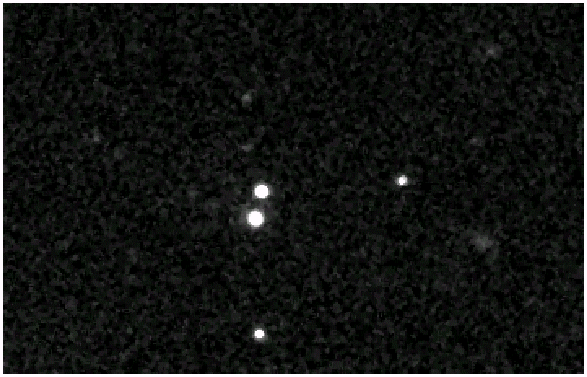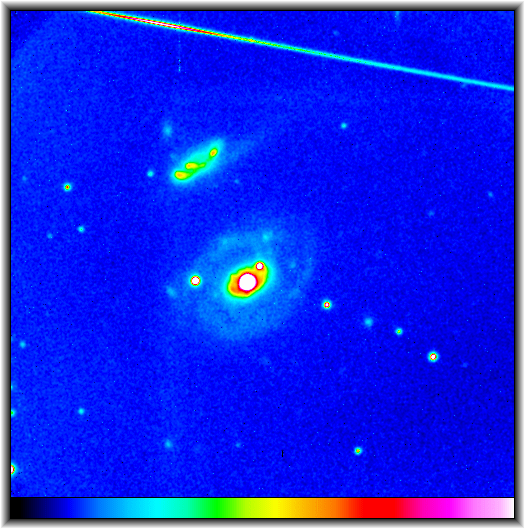| |
This frame shows a 1.8x1.3 arcmin field around the two images of the gravitationally lensed quasar 0957+561A, B (the close stelar-like objects in the centre of the frame; North is at the top, East is to the left). The lensed "A" image is the Northern one, and the lensed "B" image is the Southern one. A number of faint galaxies could be identified in the field: these galaxies are members of a foreground cluster of galaxies. The central galaxy of this cluster plays the main lensing role splitting the quasar image into two subimages separated by approximately 6 arcsec. This double imaged quasar is the first confirmed example of gravitational lensing on cosmological scales. It was discovered in 1979 by Walsh, Carswell and Weymann during a search for the optical counterparts of a complete sample of radio sources (0957 + 561 A, B - Twin quasistellar objects or gravitational lens, Nature, vol. 279, May 31, 1979, p. 381-384). This picture was obtained by Dr. A. Strigachev on March 13, 1994 00:30 UT using 2-m reflector of Rozhen NAO of Bulgaria and SBIG ST-6 CCD camera (375x242 pixels). The final image is a sum of two exposures of 300 and 500 sec duration through Cousins R filter. To suppres the noise the co-added image was median filtered using a 3x3 pixels window. The image processing was done by Dr. B. Mihov using ESO-MIDAS astronomical package. The frames used to obtain the composite picture are among the first ones taken by Bulgarian astronomers using a CCD device. By courtesy of Dr. A. Strigachev. |
| |
A meteor trail in the front of the galaxy pair NGC 7469/IC 5283. It is interesting to note in this case that the probability to capture a meteor in such narrow-field frame is very small. The spiral galaxy NGC 7469 harbors a Seyfert 1 type active nucleus, while the irregular galaxy IC 5283 has a tidal tail pointed toward North-West that is a result of the gravitational interaction with NGC 7469. This interaction could be a driven force of the nuclear activity in NGC 7469. This 100 seconds, 5x5 arcmin wide image was taken during the night of July 19/20, 1998 with the 2-m telescope of Rozhen NAO of Bulgaria and Photometrics AT200 CCD camera through Johnson B filter; North is at the top, East is to the left. A basic level adaptive filtering was applied in order to increase the S/N ratio of the final image using ESO-MIDAS package. Observers L. Slavcheva-Mihova and B. Mihov. |

